
Illustrative Math Alignment: Grade 7 Unit 8
Probability and Sampling
Lesson 19: Comparing Populations With Friends
Use the following Media4Math resources with this Illustrative Math lesson.
| Thumbnail Image | Title | Body | Curriculum Topic |
|---|---|---|---|
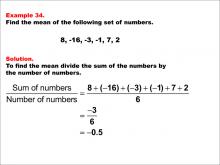
|
Math Example--Measures of Central Tendency--Mean: Example 34 | Math Example--Measures of Central Tendency--Mean: Example 34TopicMeasures of Central Tendency DescriptionThis example demonstrates the calculation of the mean for yet another set of numbers. The process involves summing all values and dividing by the count of numbers. This example is particularly instructive as it continues to reinforce the concept of finding a central value that represents the entire dataset, potentially dealing with a different range or distribution of numbers than previous examples. |
Data Analysis |
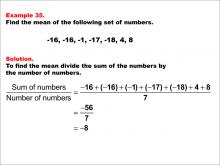
|
Math Example--Measures of Central Tendency--Mean: Example 35 | Math Example--Measures of Central Tendency--Mean: Example 35TopicMeasures of Central Tendency DescriptionThis example illustrates the calculation of the mean for a new set of numbers. The process involves summing all values and dividing by the count of numbers. This example is particularly instructive as it continues to reinforce the concept of finding a central value that represents the entire dataset, potentially dealing with a different range or distribution of numbers than previous examples. |
Data Analysis |
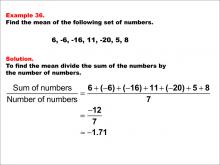
|
Math Example--Measures of Central Tendency--Mean: Example 36 | Math Example--Measures of Central Tendency--Mean: Example 36TopicMeasures of Central Tendency DescriptionThis example demonstrates the calculation of the mean for another set of numbers. The process involves summing all values and dividing by the count of numbers. This example is particularly instructive as it continues to reinforce the concept of finding a central value that represents the entire dataset, potentially dealing with a different range or distribution of numbers than previous examples. |
Data Analysis |

|
Math Example--Measures of Central Tendency--Mean: Example 37 | Math Example--Measures of Central Tendency--Mean: Example 37TopicMeasures of Central Tendency DescriptionThis example illustrates the calculation of the mean for a new set of numbers. The process involves summing all values and dividing by the count of numbers. This example is particularly instructive as it continues to reinforce the concept of finding a central value that represents the entire dataset, potentially dealing with a different range or distribution of numbers than previous examples. |
Data Analysis |

|
Math Example--Measures of Central Tendency--Mean: Example 38 | Math Example--Measures of Central Tendency--Mean: Example 38TopicMeasures of Central Tendency DescriptionThis example demonstrates the calculation of the mean for a set of numbers. The process involves summing all values and dividing by the count of numbers. This example is particularly instructive as it reinforces the concept of finding a central value that represents the entire dataset, potentially dealing with a different range or distribution of numbers than previous examples. |
Data Analysis |
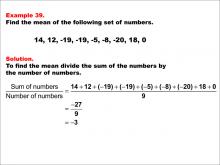
|
Math Example--Measures of Central Tendency--Mean: Example 39 | Math Example--Measures of Central Tendency--Mean: Example 39TopicMeasures of Central Tendency DescriptionThis example illustrates the calculation of the mean for a new set of numbers. The process involves summing all values and dividing by the count of numbers. This example is particularly instructive as it continues to reinforce the concept of finding a central value that represents the entire dataset, potentially dealing with a different range or distribution of numbers than previous examples. |
Data Analysis |
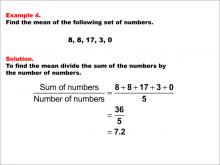
|
Math Example--Measures of Central Tendency--Mean: Example 4 | Math Example--Measures of Central Tendency--Mean: Example 4TopicMeasures of Central Tendency DescriptionThis example continues to reinforce the concept of calculating the mean, presenting a new set of numbers for analysis. It emphasizes the consistency of the process: summing all values and dividing by the count of numbers, regardless of the specific values in the dataset. The visual representation helps students see how different numbers can still lead to a single, representative value. |
Data Analysis |
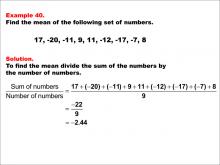
|
Math Example--Measures of Central Tendency--Mean: Example 40 | Math Example--Measures of Central Tendency--Mean: Example 40TopicMeasures of Central Tendency DescriptionThis example demonstrates the calculation of the mean for another set of numbers. The process involves summing all values and dividing by the count of numbers. This example is particularly instructive as it continues to reinforce the concept of finding a central value that represents the entire dataset, potentially dealing with a different range or distribution of numbers than previous examples. |
Data Analysis |
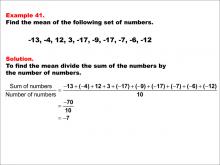
|
Math Example--Measures of Central Tendency--Mean: Example 41 | Math Example--Measures of Central Tendency--Mean: Example 41TopicMeasures of Central Tendency DescriptionThis example illustrates the calculation of the mean for a new set of numbers. The process involves summing all values and dividing by the count of numbers. This example is particularly instructive as it continues to reinforce the concept of finding a central value that represents the entire dataset, potentially dealing with a different range or distribution of numbers than previous examples. |
Data Analysis |
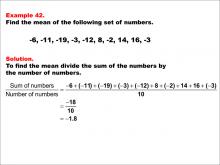
|
Math Example--Measures of Central Tendency--Mean: Example 42 | Math Example--Measures of Central Tendency--Mean: Example 42TopicMeasures of Central Tendency DescriptionThis example demonstrates the calculation of the mean for another set of numbers. The process involves summing all values and dividing by the count of numbers. This example is particularly instructive as it continues to reinforce the concept of finding a central value that represents the entire dataset, potentially dealing with a different range or distribution of numbers than previous examples. |
Data Analysis |
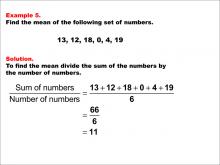
|
Math Example--Measures of Central Tendency--Mean: Example 5 | Math Example--Measures of Central Tendency--Mean: Example 5TopicMeasures of Central Tendency DescriptionThis fifth example in the series on calculating the mean introduces yet another set of numbers, further reinforcing the universality of the concept. It demonstrates how the process of finding the mean remains consistent: summing all values and dividing by the count of numbers, regardless of the specific values or the size of the dataset. The visual representation continues to aid in understanding the step-by-step process. |
Data Analysis |
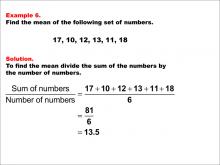
|
Math Example--Measures of Central Tendency--Mean: Example 6 | Math Example--Measures of Central Tendency--Mean: Example 6TopicMeasures of Central Tendency DescriptionThis sixth example in the series on calculating the mean introduces a new set of numbers, further solidifying the concept and its application. It reiterates the consistent process of finding the mean: summing all values and dividing by the count of numbers, regardless of the specific values in the dataset. The visual representation continues to support understanding of each step in the calculation. |
Data Analysis |
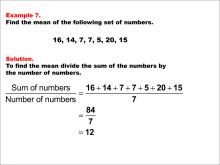
|
Math Example--Measures of Central Tendency--Mean: Example 7 | Math Example--Measures of Central Tendency--Mean: Example 7TopicMeasures of Central Tendency DescriptionThis seventh example in the series on calculating the mean presents yet another set of numbers, further reinforcing the concept and its application in various scenarios. It continues to demonstrate the consistent process of finding the mean: summing all values and dividing by the count of numbers, regardless of the specific values or the size of the dataset. The visual representation aids in understanding each step of the calculation process. |
Data Analysis |
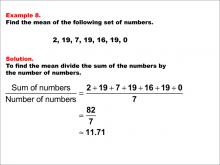
|
Math Example--Measures of Central Tendency--Mean: Example 8 | Math Example--Measures of Central Tendency--Mean: Example 8TopicMeasures of Central Tendency DescriptionThis example demonstrates the calculation of the mean for a set of numbers: 2, 19, 7, 19, 16, 19, and 0. The process involves summing all values and dividing by the count of numbers, resulting in an average of approximately 11.71. This example reinforces the concept of finding a central value that represents the entire dataset. |
Data Analysis |
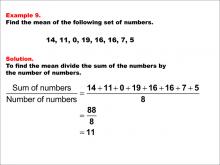
|
Math Example--Measures of Central Tendency--Mean: Example 9 | Math Example--Measures of Central Tendency--Mean: Example 9TopicMeasures of Central Tendency DescriptionThis example illustrates the calculation of the mean for the numbers 14, 11, 0, 19, 16, 16, 7, and 5. The process involves summing all values (88) and dividing by the count of numbers (8), resulting in a mean of 11. This example showcases how the mean can provide a central value that represents a diverse set of numbers, including zero. |
Data Analysis |

|
Math Example--Measures of Central Tendency--Median: Example 1 | Math Example--Measures of Central Tendency--Median: Example 1TopicMeasures of Central Tendency DescriptionThis example demonstrates how to find the median of a set of numbers: 14, 35, 37, 28, 38, 28, 14, 12. The process involves arranging the numbers in ascending order and identifying the middle value. In this case, with an even number of terms, the median is calculated by finding the average of the two middle terms, resulting in a median of 28. |
Data Analysis |
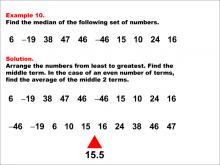
|
Math Example--Measures of Central Tendency--Median: Example 10 | Math Example--Measures of Central Tendency--Median: Example 10TopicMeasures of Central Tendency DescriptionThis example demonstrates finding the median of the following set of numbers: 6, -19, 38, 47, 46, -46, 15, 10, 24, 16. The solution involves arranging the numbers from least to greatest and then identifying the middle value. With an even number of terms, the median is calculated as the average of the two middle terms, resulting in a median of 15.5. |
Data Analysis |
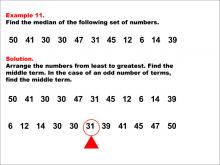
|
Math Example--Measures of Central Tendency--Median: Example 11 | Math Example--Measures of Central Tendency--Median: Example 11TopicMeasures of Central Tendency DescriptionThis example illustrates the process of finding the median for the set of numbers: 50, 41, 30, 30, 47, 31, 45, 12, 6, 14, 39. The solution involves arranging the numbers from least to greatest and then identifying the middle value. With an odd number of terms, the median is simply the middle number after sorting, which is 31. |
Data Analysis |
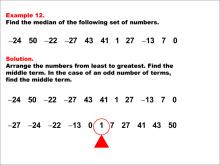
|
Math Example--Measures of Central Tendency--Median: Example 12 | Math Example--Measures of Central Tendency--Median: Example 12TopicMeasures of Central Tendency DescriptionThis example demonstrates finding the median of the following set of numbers: -24, 50, -22, -27, 43, 41, 1, 27, -13, 7, 0. The solution involves arranging the numbers from least to greatest and then identifying the middle value. With an odd number of terms, the median is simply the middle number after sorting, which is 1. |
Data Analysis |
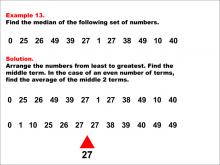
|
Math Example--Measures of Central Tendency--Median: Example 13 | Math Example--Measures of Central Tendency--Median: Example 13TopicMeasures of Central Tendency DescriptionThis example illustrates the process of finding the median for the set of numbers: 0, 25, 26, 49, 39, 27, 1, 27, 38, 49, 10, 40. The solution involves arranging the numbers from least to greatest and then identifying the middle value. With an even number of terms, the median is calculated as the average of the two middle terms, resulting in a median of 27. |
Data Analysis |

|
Math Example--Measures of Central Tendency--Median: Example 14 | Math Example--Measures of Central Tendency--Median: Example 14TopicMeasures of Central Tendency DescriptionThis example demonstrates finding the median of the following set of numbers: 45, 2, 20, 2, 37, 11, 46, 49, 21, 27, 50, 45. The solution involves arranging the numbers from least to greatest and then identifying the middle value. With an even number of terms, the median is calculated as the average of the two middle terms, resulting in a median of 32. |
Data Analysis |
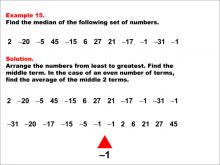
|
Math Example--Measures of Central Tendency--Median: Example 15 | Math Example--Measures of Central Tendency--Median: Example 15TopicMeasures of Central Tendency DescriptionThis example illustrates the process of finding the median for the set of numbers: 2, -20, -5, 45, -15, 6, 27, 21, -17, -1, -31, -1. The solution involves arranging the numbers from least to greatest and then identifying the middle value. With an even number of terms, the median is calculated as the average of the two middle terms, resulting in a median of -1. |
Data Analysis |
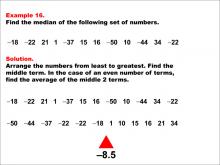
|
Math Example--Measures of Central Tendency--Median: Example 16 | Math Example--Measures of Central Tendency--Median: Example 16TopicMeasures of Central Tendency DescriptionThis example demonstrates finding the median of the following set of numbers: -18, -22, 21, 1, -37, 15, 16, -50, 10, -44, 34, -22. The solution involves arranging the numbers from least to greatest and then identifying the middle value. With an even number of terms, the median is calculated as the average of the two middle terms, resulting in a median of -8.5. |
Data Analysis |
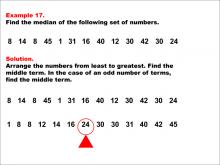
|
Math Example--Measures of Central Tendency--Median: Example 17 | Math Example--Measures of Central Tendency--Median: Example 17TopicMeasures of Central Tendency DescriptionThis example illustrates the process of finding the median for the set of numbers: 8, 14, 8, 45, 1, 31, 16, 40, 12, 30, 42, 30, 24. The solution involves arranging the numbers from least to greatest and then identifying the middle value. With an odd number of terms, the median is simply the middle number after sorting, which is 24. |
Data Analysis |
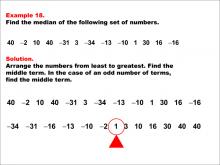
|
Math Example--Measures of Central Tendency--Median: Example 18 | Math Example--Measures of Central Tendency--Median: Example 18TopicMeasures of Central Tendency DescriptionThis example demonstrates finding the median of the following set of numbers: 40, -2, 10, 40, -31, 3, -34, -13, -10, 1, 30, 16, -16. The solution involves arranging the numbers from least to greatest and then identifying the middle value. With an odd number of terms, the median is simply the middle number after sorting, which is 1. |
Data Analysis |
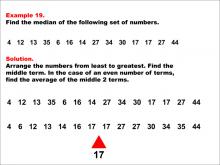
|
Math Example--Measures of Central Tendency--Median: Example 19 | Math Example--Measures of Central Tendency--Median: Example 19TopicMeasures of Central Tendency DescriptionThis example illustrates the process of finding the median for the set of numbers: 4, 12, 13, 35, 6, 16, 14, 27, 34, 30, 17, 17, 27, 44. The solution involves arranging the numbers from least to greatest and then identifying the middle value. With an even number of terms, the median is calculated as the average of the two middle terms, resulting in a median of 17. |
Data Analysis |
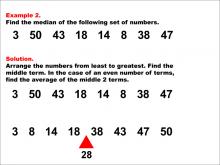
|
Math Example--Measures of Central Tendency--Median: Example 2 | Math Example--Measures of Central Tendency--Median: Example 2TopicMeasures of Central Tendency DescriptionThis example illustrates the process of finding the median for the set of numbers: 3, 50, 43, 18, 14, 8, 38, 47. The solution involves arranging the numbers from least to greatest and then identifying the middle value. With an even number of terms, the median is calculated as the average of the two middle terms, resulting in a median of 28. |
Data Analysis |

|
Math Example--Measures of Central Tendency--Median: Example 20 | Math Example--Measures of Central Tendency--Median: Example 20TopicMeasures of Central Tendency DescriptionThis example demonstrates finding the median of the following set of numbers: 37, 6, 37, 36, 7, 28, 24, 30, 37, 39, 46, 12, 29, 23. The solution involves arranging the numbers from least to greatest and then identifying the middle value. With an even number of terms, the median is calculated as the average of the two middle terms, resulting in a median of 29.5. |
Data Analysis |
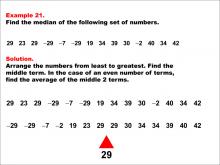
|
Math Example--Measures of Central Tendency--Median: Example 21 | Math Example--Measures of Central Tendency--Median: Example 21TopicMeasures of Central Tendency DescriptionThis example illustrates the process of finding the median for the set of numbers: 29, 23, 29, -29, -7, -29, 19, 34, 39, 30, -2, 40, 34, 42. The solution involves arranging the numbers from least to greatest and then identifying the middle value. With an even number of terms, the median is calculated as the average of the two middle terms, resulting in a median of 29. |
Data Analysis |
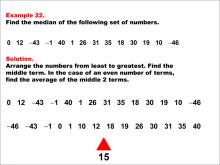
|
Math Example--Measures of Central Tendency--Median: Example 22 | Math Example--Measures of Central Tendency--Median: Example 22TopicMeasures of Central Tendency DescriptionThis example demonstrates finding the median of the following set of numbers: 0, 12, -43, -1, 40, 1, 26, 31, 35, 18, 30, 19, 10, -46. The solution involves arranging the numbers from least to greatest and then identifying the middle value. With an even number of terms, the median is calculated as the average of the two middle terms, resulting in a median of 15. |
Data Analysis |
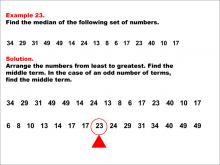
|
Math Example--Measures of Central Tendency--Median: Example 23 | Math Example--Measures of Central Tendency--Median: Example 23TopicMeasures of Central Tendency DescriptionThis example illustrates the process of finding the median for the set of numbers: 34, 29, 31, 49, 49, 14, 24, 13, 8, 6, 17, 23, 40, 10, 17. The solution involves arranging the numbers from least to greatest and then identifying the middle value. With an odd number of terms, the median is simply the middle number after sorting, which is 23. |
Data Analysis |
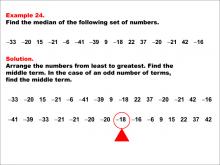
|
Math Example--Measures of Central Tendency--Median: Example 24 | Math Example--Measures of Central Tendency--Median: Example 24TopicMeasures of Central Tendency DescriptionThis example demonstrates finding the median of the following set of numbers: -33, -20, 15, -21, -6, -41, -39, 9, -18, 22, 37, -20, -21, 42, -16. The solution involves arranging the numbers from least to greatest and then identifying the middle value. With an odd number of terms, the median is simply the middle number after sorting, which is -18. |
Data Analysis |
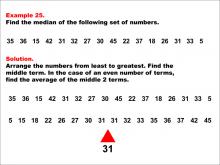
|
Math Example--Measures of Central Tendency--Median: Example 25 | Math Example--Measures of Central Tendency--Median: Example 25TopicMeasures of Central Tendency DescriptionThis example illustrates the process of finding the median for the set of numbers: 35, 36, 15, 42, 31, 32, 27, 30, 45, 22, 37, 18, 26, 31, 33, 5. The solution involves arranging the numbers from least to greatest and then identifying the middle value. With an even number of terms, the median is calculated as the average of the two middle terms, resulting in a median of 31. |
Data Analysis |
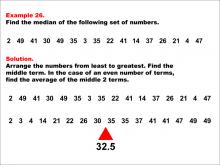
|
Math Example--Measures of Central Tendency--Median: Example 26 | Math Example--Measures of Central Tendency--Median: Example 26TopicMeasures of Central Tendency DescriptionThis example demonstrates finding the median of the following set of numbers: 2, 49, 41, 30, 49, 35, 3, 35, 22, 41, 14, 37, 26, 21, 4, 47. The solution involves arranging the numbers from least to greatest and then identifying the middle value. With an even number of terms, the median is calculated as the average of the two middle terms, resulting in a median of 32.5. |
Data Analysis |

|
Math Example--Measures of Central Tendency--Median: Example 27 | Math Example--Measures of Central Tendency--Median: Example 27TopicMeasures of Central Tendency DescriptionThis example illustrates the process of finding the median for the set of numbers: 3, -43, 39, 29, 0, -23, 16, -35, 3, 32, -45, 2, -50, 7, 40, 24. The solution involves arranging the numbers from least to greatest and then identifying the middle value. With an even number of terms, the median is calculated as the average of the two middle terms, resulting in a median of 3. |
Data Analysis |
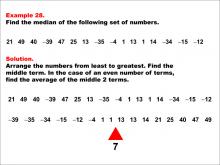
|
Math Example--Measures of Central Tendency--Median: Example 28 | Math Example--Measures of Central Tendency--Median: Example 28TopicMeasures of Central Tendency DescriptionThis example demonstrates finding the median of the following set of numbers: 21, 49, 40, -39, 47, 25, 13, -35, -4, 1, 13, 1, 14, -34, -15, -12. The solution involves arranging the numbers from least to greatest and then identifying the middle value. With an even number of terms, the median is calculated as the average of the two middle terms, resulting in a median of 7. |
Data Analysis |
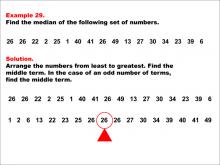
|
Math Example--Measures of Central Tendency--Median: Example 29 | Math Example--Measures of Central Tendency--Median: Example 29TopicMeasures of Central Tendency DescriptionThis example illustrates the process of finding the median for the set of numbers: 26, 26, 22, 2, 25, 1, 40, 41, 26, 49, 13, 27, 30, 34, 23, 39, 6. The solution involves arranging the numbers from least to greatest and then identifying the middle value. With an odd number of terms, the median is simply the middle number after sorting, which is 26. |
Data Analysis |
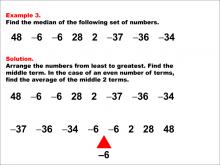
|
Math Example--Measures of Central Tendency--Median: Example 3 | Math Example--Measures of Central Tendency--Median: Example 3TopicMeasures of Central Tendency DescriptionThis example demonstrates finding the median of the following set of numbers: 48, -6, -6, 28, 2, -37, -36, -34. The solution involves arranging the numbers from least to greatest and then identifying the middle value. With an even number of terms, the median is calculated as the average of the two middle terms, resulting in a median of -6. |
Data Analysis |

|
Math Example--Measures of Central Tendency--Median: Example 30 | Math Example--Measures of Central Tendency--Median: Example 30TopicMeasures of Central Tendency DescriptionThis example demonstrates finding the median of the following set of numbers: 20, 30, 17, -36, 26, 6, 8, -30, -21, 0, 42, -19, -34, 39, 6, -18, 24. The solution involves arranging the numbers from least to greatest and then identifying the middle value. With an odd number of terms, the median is simply the middle number after sorting, which is 6. |
Data Analysis |
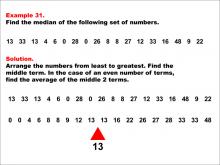
|
Math Example--Measures of Central Tendency--Median: Example 31 | Math Example--Measures of Central Tendency--Median: Example 31TopicMeasures of Central Tendency DescriptionThis example illustrates the process of finding the median for the set of numbers: 13, 33, 13, 4, 6, 0, 28, 0, 26, 8, 8, 27, 12, 33, 16, 48, 9, 22. The solution involves arranging the numbers from least to greatest and then identifying the middle value. With an even number of terms, the median is calculated as the average of the two middle terms, resulting in a median of 13. |
Data Analysis |
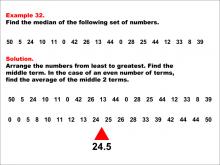
|
Math Example--Measures of Central Tendency--Median: Example 32 | Math Example--Measures of Central Tendency--Median: Example 32TopicMeasures of Central Tendency DescriptionThis example demonstrates finding the median of the following set of numbers: 50, 5, 24, 10, 11, 0, 42, 26, 13, 44, 0, 28, 25, 44, 12, 33, 8, 39. The solution involves arranging the numbers from least to greatest and then identifying the middle value. With an even number of terms, the median is calculated as the average of the two middle terms, resulting in a median of 24.5. |
Data Analysis |

|
Math Example--Measures of Central Tendency--Median: Example 33 | Math Example--Measures of Central Tendency--Median: Example 33TopicMeasures of Central Tendency DescriptionThis example illustrates the process of finding the median for the set of numbers: -22, 30, -39, 46, 50, 27, -42, -15, 15, -14, 47, -31, 21, -2, -27, -9, -22, -9. The solution involves arranging the numbers from least to greatest and then identifying the middle value. With an even number of terms, the median is calculated as the average of the two middle terms, resulting in a median of -4.5. |
Data Analysis |

|
Math Example--Measures of Central Tendency--Median: Example 34 | Math Example--Measures of Central Tendency--Median: Example 34TopicMeasures of Central Tendency DescriptionThis example demonstrates finding the median of the following set of numbers: -4, -44, 24, -48, 35, -3, 50, 34, -32, 42, 11, 22, -49, -4, -31, 41, 30, 17. The solution involves arranging the numbers from least to greatest and then identifying the middle value. With an even number of terms, the median is calculated as the average of the two middle terms, resulting in a median of 14. |
Data Analysis |
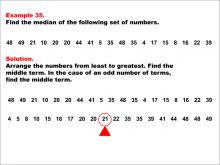
|
Math Example--Measures of Central Tendency--Median: Example 35 | Math Example--Measures of Central Tendency--Median: Example 35TopicMeasures of Central Tendency DescriptionThis example illustrates the process of finding the median for the set of numbers: 48, 49, 21, 10, 20, 20, 44, 41, 5, 35, 48, 35, 4, 17, 15, 8, 16, 22, 39. The solution involves arranging the numbers from least to greatest and then identifying the middle value. With an odd number of terms, the median is simply the middle number after sorting, which is 21. |
Data Analysis |
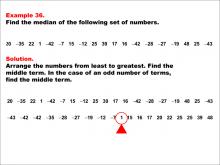
|
Math Example--Measures of Central Tendency--Median: Example 36 | Math Example--Measures of Central Tendency--Median: Example 36TopicMeasures of Central Tendency DescriptionThis example demonstrates finding the median of the following set of numbers: 20, -35, 22, 1, -42, -7, 15, -12, 25, 39, 17, 16, -42, -28, -27, -19, 48, 25, -43. The solution involves arranging the numbers from least to greatest and then identifying the middle value. With an odd number of terms, the median is simply the middle number after sorting, which is 1. |
Data Analysis |
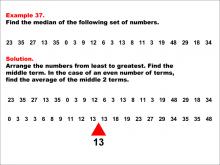
|
Math Example--Measures of Central Tendency--Median: Example 37 | Math Example--Measures of Central Tendency--Median: Example 37TopicMeasures of Central Tendency DescriptionThis example illustrates the process of finding the median for the set of numbers: 3, 1, 4, 2, 5. The solution involves arranging the numbers from least to greatest and then identifying the middle value. With an odd number of terms, the median is simply the middle number after sorting, which is 3. |
Data Analysis |
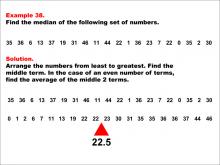
|
Math Example--Measures of Central Tendency--Median: Example 38 | Math Example--Measures of Central Tendency--Median: Example 38TopicMeasures of Central Tendency DescriptionThis example demonstrates finding the median of the following set of numbers: 3, 5, 1, 4, 2. The solution involves arranging the numbers from least to greatest and then identifying the middle value. With an odd number of terms, the median is simply the middle number after sorting, which is 3. |
Data Analysis |
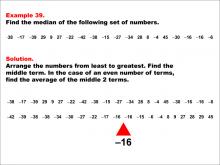
|
Math Example--Measures of Central Tendency--Median: Example 39 | Math Example--Measures of Central Tendency--Median: Example 39TopicMeasures of Central Tendency DescriptionThis example illustrates the process of finding the median for the set of numbers: 2, 5, 7, 10, 12. The solution involves arranging the numbers from least to greatest and then identifying the middle value. With an odd number of terms, the median is simply the middle number after sorting, which is 7. |
Data Analysis |

|
Math Example--Measures of Central Tendency--Median: Example 4 | Math Example--Measures of Central Tendency--Median: Example 4TopicMeasures of Central Tendency DescriptionThis example illustrates the process of finding the median for the set of numbers: 13, -20, 4, -4, -43, 46, -17, -19. The solution involves arranging the numbers from least to greatest and then identifying the middle value. With an even number of terms, the median is calculated as the average of the two middle terms, resulting in a median of -10/5 or -2. |
Data Analysis |
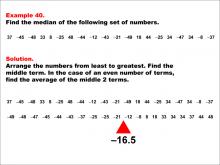
|
Math Example--Measures of Central Tendency--Median: Example 40 | Math Example--Measures of Central Tendency--Median: Example 40TopicMeasures of Central Tendency DescriptionThis example demonstrates the general process of finding the median for a set of numbers. The solution involves arranging the numbers from least to greatest and then identifying the middle value. The procedure differs slightly depending on whether there is an odd or even number of terms in the dataset. |
Data Analysis |